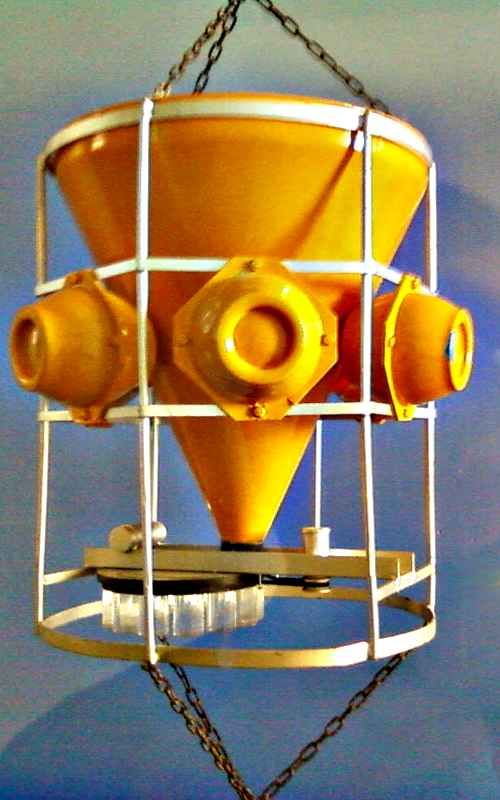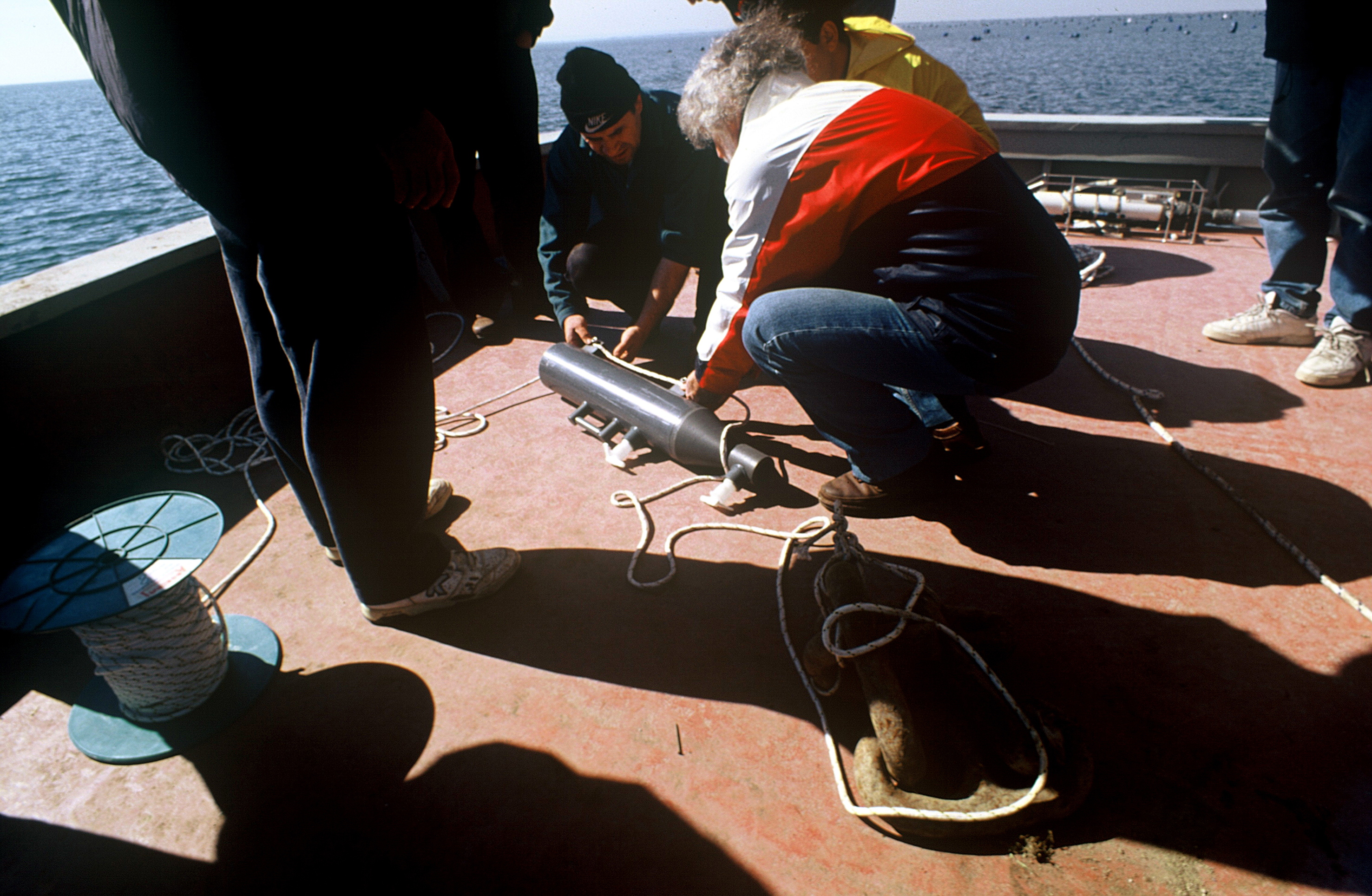Sediment trap on:
[Wikipedia]
[Google]
[Amazon]
 Sediment traps are instruments used in oceanography and
Sediment traps are instruments used in oceanography and  Traps are often
Traps are often
 Sediment traps are instruments used in oceanography and
Sediment traps are instruments used in oceanography and limnology
Limnology ( ; from Greek λίμνη, ''limne'', "lake" and λόγος, ''logos'', "knowledge") is the study of inland aquatic ecosystems.
The study of limnology includes aspects of the biological, chemical, physical, and geological characteris ...
to measure the quantity of sinking particulate organic (and inorganic
In chemistry, an inorganic compound is typically a chemical compound that lacks carbon–hydrogen bonds, that is, a compound that is not an organic compound. The study of inorganic compounds is a subfield of chemistry known as ''inorganic chemist ...
) material in aquatic systems
Aquatic means relating to water; living in or near water or taking place in water; does not include groundwater, as "aquatic" implies an environment where plants and animals live.
Aquatic(s) may also refer to:
* Aquatic animal, either vertebrate ...
, usually ocean
The ocean (also the sea or the world ocean) is the body of salt water that covers approximately 70.8% of the surface of Earth and contains 97% of Earth's water. An ocean can also refer to any of the large bodies of water into which the wo ...
s, lakes, or reservoirs
A reservoir (; from French ''réservoir'' ) is an enlarged lake behind a dam. Such a dam may be either artificial, built to store fresh water or it may be a natural formation.
Reservoirs can be created in a number of ways, including control ...
. This flux of material is the product of biological and ecological
Ecology () is the study of the relationships between living organisms, including humans, and their physical environment. Ecology considers organisms at the individual, population, community, ecosystem, and biosphere level. Ecology overlaps wi ...
processes typically within the surface euphotic zone, and is of interest to scientist
A scientist is a person who conducts scientific research to advance knowledge in an area of the natural sciences.
In classical antiquity, there was no real ancient analog of a modern scientist. Instead, philosophers engaged in the philosoph ...
s studying the role of the biological pump
The biological pump (or ocean carbon biological pump or marine biological carbon pump) is the ocean's biologically driven sequestration of carbon from the atmosphere and land runoff to the ocean interior and seafloor sediments.Sigman DM & GH ...
in the carbon cycle
The carbon cycle is the biogeochemical cycle by which carbon is exchanged among the biosphere, pedosphere, geosphere, hydrosphere, and atmosphere of the Earth. Carbon is the main component of biological compounds as well as a major componen ...
.
Sediments traps normally consist of an upward-facing funnel
A funnel is a tube or pipe that is wide at the top and narrow at the bottom, used for guiding liquid or powder into a small opening.
Funnels are usually made of stainless steel, aluminium, glass, or plastic. The material used in its construct ...
that directs sinking particulate matter (e.g. marine snow
In the deep ocean, marine snow (also known as "ocean dandruff") is a continuous shower of mostly organic detritus falling from the upper layers of the water column. It is a significant means of exporting energy from the light-rich photic zone to ...
) towards a mechanism for collection and preservation. Typically, traps operate over an extended period of time (weeks to months) and their collection mechanisms may consist of a series of sampling vessels that are cycled through to allow the trap to record the changes in sinking flux with time (for instance, across a seasonal cycle). Preservation of collected material is necessary because of these long deployments, and prevents sample decomposition
Decomposition or rot is the process by which dead organic substances are broken down into simpler organic or inorganic matter such as carbon dioxide, water, simple sugars and mineral salts. The process is a part of the nutrient cycle and is e ...
and its consumption
Consumption may refer to:
*Resource consumption
*Tuberculosis, an infectious disease, historically
* Consumption (ecology), receipt of energy by consuming other organisms
* Consumption (economics), the purchasing of newly produced goods for curren ...
by zooplankton
Zooplankton are the animal component of the planktonic community ("zoo" comes from the Greek word for ''animal''). Plankton are aquatic organisms that are unable to swim effectively against currents, and consequently drift or are carried along by ...
"swimmers".
 Traps are often
Traps are often moored
A mooring is any permanent structure to which a vessel may be secured. Examples include quays, wharfs, jetties, piers, anchor buoys, and mooring buoys. A ship is secured to a mooring to forestall free movement of the ship on the water. An ''an ...
at a specific depth in the water column
A water column is a conceptual column of water from the surface of a sea, river or lake to the bottom sediment.Munson, B.H., Axler, R., Hagley C., Host G., Merrick G., Richards C. (2004).Glossary. ''Water on the Web''. University of Minnesota-D ...
(usually below the euphotic zone or mixed layer
The oceanic or limnological mixed layer is a layer in which active turbulence has homogenized some range of depths. The surface mixed layer is a layer where this turbulence is generated by winds, surface heat fluxes, or processes such as evaporat ...
) in a particular location, but some are so-called Lagrangian traps that drift with the surrounding ocean current
An ocean current is a continuous, directed movement of sea water generated by a number of forces acting upon the water, including wind, the Coriolis effect, breaking waves, cabbeling, and temperature and salinity differences. Depth contours ...
s (though they may remain at a fixed depth). These latter traps travel with the biological systems that they study, while moored traps are subject to variability introduced by different systems (or states of systems) "passing by". However, because of their fixed location moored traps are straightforward to recover for analysis of their measurements. Lagrangian traps must surface at a pre-determined time, and report their position (usually via satellite
A satellite or artificial satellite is an object intentionally placed into orbit in outer space. Except for passive satellites, most satellites have an electricity generation system for equipment on board, such as solar panels or radioi ...
) in order to be recovered.
See also
*Biological pump
The biological pump (or ocean carbon biological pump or marine biological carbon pump) is the ocean's biologically driven sequestration of carbon from the atmosphere and land runoff to the ocean interior and seafloor sediments.Sigman DM & GH ...
* f-ratio
* Marine snow
In the deep ocean, marine snow (also known as "ocean dandruff") is a continuous shower of mostly organic detritus falling from the upper layers of the water column. It is a significant means of exporting energy from the light-rich photic zone to ...
* Mooring (oceanography)
current_meter.html" ;"title="sediment traps and current meter">sediment traps and current meters -->
A mooring in oceanography is a collection of devices connected to a wire and anchored on the sea floor. It is the ''Lagrangian and Eulerian speci ...
* Primary production
In ecology, primary production is the synthesis of organic compounds from atmospheric or aqueous carbon dioxide. It principally occurs through the process of photosynthesis, which uses light as its source of energy, but it also occurs through ...
References
{{aquatic ecosystem topics Oceanographic instrumentation Limnology